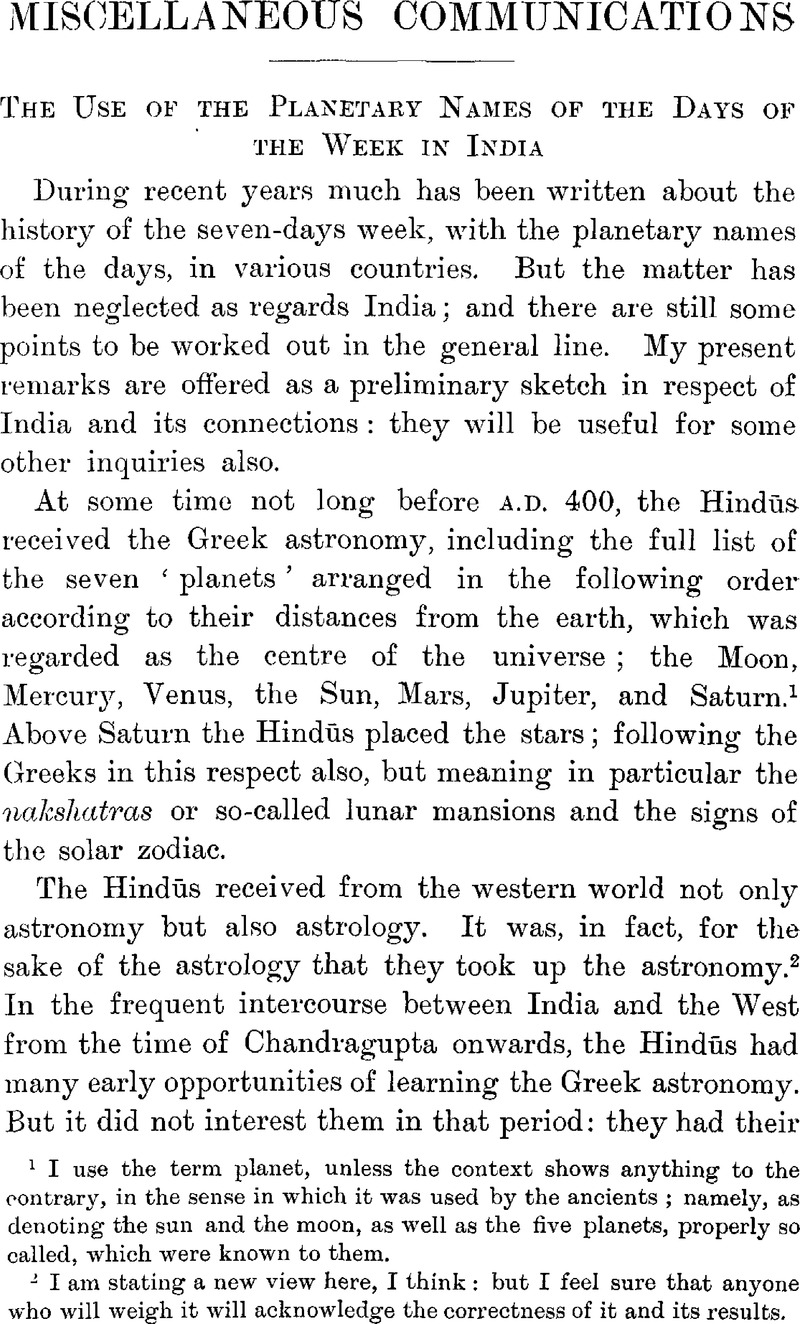No CrossRef data available.
Published online by Cambridge University Press: 15 March 2011

page 1039 note 1 I use the term planet, unless the context shows anything to the contrary, in the sense in which it was used by the ancients; namely, as denoting the sun and the moon, as well as the five planets, properly so called, which were known to them.
page 1039 note 2 I am stating a new view here, I think: but I feel sure that anyone who will weigh it will acknowledge the correctness of it and its results.
page 1040 note 1 Bouchè-Leclercq, has said:—“Son but a été, dit-il, de combler dans la littérature latine la seule lacune qui y existât encore:” L'Astrologie Grecque, introd., p. 14Google Scholar.
page 1040 note 2 I do not overlook the point that the five planets properly so called are mentioned (in no definite order: Venus, Jupiter, Saturn, Mercury, Mars) towards the end of the Śārdūlakarṇāvadāna, which was translated into Chinese in the third century: see the Divyāvadāna, ed. Cowell and Neil, p. 642, line 15. The editors, however, felt doubtful (p. 655) as to the date of some of the later parts of this writing: and M. Sylvain Lévi tells me that this reference to the planets is not in the corresponding place in the Chinese version.
page 1041 note 1 The rule is not in the work of Firmieus Maternus, I think: at any rate, I have not been able to find it there.
page 1041 note 2 There is, of course, nothing in nature to connect any particular planet with any particular day.
page 1043 note 1 There is also the point that a name of Sunday is Ādivāra, ‘the beginning-day’: but this might be explained by the fact that according to the school to which Brahmagupta belonged creation began on a Sunday. There is here, by the way, a curious agreement with the Biblical position: but it is only a coincidence, due to the number of days assigned by Brahmagupta to the Kalpa (that is, due to the exact length of the solar year taken by him) and applied to the cardinal point of Friday, 18 February, b.c. 3102, as the beginning of the present Kali age.
page 1043 note 2 Chapter 5 deals with Rāhu, the ascending node, between the Moon and Mars.
page 1043 note 3 Literature does not help; as, indeed, might perhaps be expected. The planetary names of the days were used occasionally in the astronomical writings from a.d. 499 onwards: as, for instance, when Āryabhata mentions “the Bhārata Thursday”, the day which preceded the beginning of the present Kali age (see this Journal, 1911. 678), and says that the revolutions of the sun and the other basic elements are to be counted from sunrise on a Wednesday at Laṅkā; and when Brahmagupta tells us that the process of creation began on a Sunday. They are also found in the Vishṇusmṛiti, chap. 78: SBE, 7. 242. They are mentioned, in at least some of the Purāṇas. Mention is made of Wednesday in the Vaikhānasa-Sūtra (see Macdonell, , Sanskrit Literature, p. 262Google Scholar). And occasional references to the names might perhaps be found in other legal and technical works. But such instances, except those in the astronomical books, are not dated ones: and though there is a chance that early dated manuscripts might yield some instances likely to be of use to us, this source of information still remains to be explored.
From general literature, —the drama, the kārya, the prose stories, and so on,— there is forthcoming, I believe, only one instance, otherwise than in passages expressly devoted to recording dates, as, e.g., in a South-Indian Praśasti of a.d. 897, and in a series of dates, ranging from a.d. 746 onwards, which are put forward as historical items in the Prabandhachintāmaṇi (written a.d. 1305). And this instance, also, is not a dated one. Still, it seems worthy of a special comment, for which I refer to p. 1045 below.
page 1044 note 1 Fleet, , Gupta Inscriptions, p. 89Google Scholar: Kielhorn, , List of the Inscriptions of Northern India, Epi. Ind., vol. 5, appendix, No. 454Google Scholar. We shall not be surprised if we should obtain hereafter evidence carrying back the use of the names of the days to an earlier date than this; indeed, to any time about, say, a.d. 375–400. But there we shall stop; for the simple reason that it was as part and parcel of the Greek astrology that the Hindūs received the idea of the planets as name-givers to the days.
page 1044 note 2 Kielhorn, , List of the Inscriptions of Southern India, Epi. Ind., vol. 7, appendix, No. 550Google Scholar.
page 1045 note 1 Inscriptions at Mī-so'n; Bulletin de I'École Française d'Extrême Orient, vol. 3 (1903), p. 210, and vol. 4 (1904), p. 920Google Scholar: I am indebted to M. George Coedes for these two references.
page 1045 note 2 In corroboration of this position down to at any rate a certain time, we may cite the point that Hiuen-tsiang found nothing to say about this detail in his account of the Hindū astronomy and calendar written at some time between a.d. 630 and 644 (Beal, , Si-yu-ki, 1. 71–3Google Scholar), though it is a feature which could hardly have failed to attract his attention, and to be noted by him, if it had been generally prevalent then.